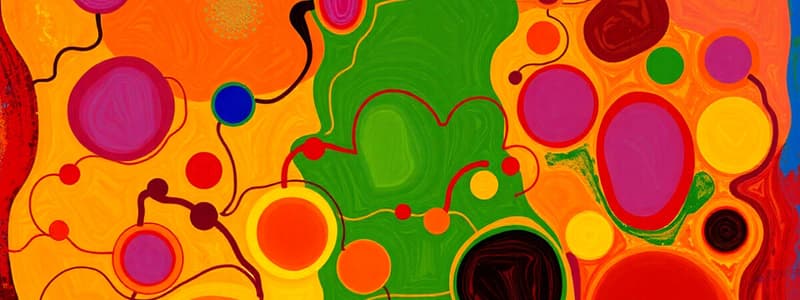Podcast
Questions and Answers
What primarily characterizes a hypertrophic scar?
What primarily characterizes a hypertrophic scar?
Which factors are associated with an increased incidence of hypertrophic scars?
Which factors are associated with an increased incidence of hypertrophic scars?
How long may hypertrophic scars take to regress after their rapid growth phase?
How long may hypertrophic scars take to regress after their rapid growth phase?
What is a common characteristic of keloid scars?
What is a common characteristic of keloid scars?
Signup and view all the answers
Which demographic has a notably higher incidence of keloid scars?
Which demographic has a notably higher incidence of keloid scars?
Signup and view all the answers
What describes the histological characteristics of a scar with disorganized collagen bundles?
What describes the histological characteristics of a scar with disorganized collagen bundles?
Signup and view all the answers
Which device is used to measure the pliability of a scar?
Which device is used to measure the pliability of a scar?
Signup and view all the answers
What is the purpose of using a durometer in scar assessment?
What is the purpose of using a durometer in scar assessment?
Signup and view all the answers
Which method provides information about the color of a scar?
Which method provides information about the color of a scar?
Signup and view all the answers
What does the laser Doppler perfusion imaging specifically evaluate in scar assessment?
What does the laser Doppler perfusion imaging specifically evaluate in scar assessment?
Signup and view all the answers
Study Notes
Hypertrophic Scar Definition
- A lumpy collagen or fibrous tissue that stays within the wound's borders.
- Caused by an exaggerated response to wound healing.
- Occurs within 4-8 weeks post-wound infection or closure.
- Associated with excess tension or contraction of the wound.
- Exhibits rapid growth up to 6 months.
- Gradually regresses over a few years, becoming a mature flat scar.
Factors Affecting Scar Formation
- Age: More prevalent in the second and third decades due to increased blood supply and wound contraction.
- Location: Common in areas with high tension, like neck, shoulders, pre-sternum, knees, and ankles.
- Depth: Deeper wounds (full and deep partial thickness burns) tend to form larger scars than superficial ones.
- Race: More frequent in darker skin.
Incidence of Hypertrophic Scar
- 40-70% post-surgery
- Up to 91% post-burn
Keloid Scars
- A firm, smooth, hard growth due to spontaneous scar formation.
- Can appear soon after injury or develop months later.
- Often itchy and extends beyond the original wound.
- Commonly found on upper chest and shoulders.
- Incidence: 6-16% in African populations
Objective Scar Assessment
-
Pliability:
- Cutometer: A non-invasive suction device that measures vertical deformation of the scar.
- Tonometer: Non-invasive device measuring tissue deformation via constant pressure.
- Color: Determined using chromameter, mexameter, tristimulus colorimeter for erythema & melanin index assessment.
- Perfusion: Laser doppler perfusion imaging measuring RBCs in skin for burn depth estimation
- Thickness: Ultrasound scanner for high-frequency sound wave echo analysis of tissues.
- Firmness: Durometer used for applying vertical load on the scar to measure firmness.
-
Surface Area/Volume
- Planimetry: measures surface area of the scar
- Linear/Tracing methods: Using a ruler and transparent metrigraph paper, respectively, to measure length and width. 3D topography captures scar volume.
Subjective Scar Assessment Scales
-
Vancouver Scar Scale (VSS): Evaluates vascularity, pigmentation, pliability, and height of the scar.
- Includes various scar characteristics' scores for evaluating the scar
- Patient and Observer Scar Assessment Scale (POSAS): Assessing patient and observer perceptions of scar characteristics (e.g., pain, itching, appearance).
- Visual Analogue Scale (VAS): Measuring subjective pain sensation using a visual scale with labeled facial expressions.
- Stony Brook Scar Evaluation Scale (SBSES): A subjective scoring system assessing scar characteristics such as width, height, color, overall appearance based on defined categories.
Scar Treatment
-
Pharmacological Treatment:
- Steroid Injections: Direct injection into the scar/keloid to reduce inflammation and increase pliability.
-
Physical Therapy Treatment:
- Silicone Gel Sheeting: Applied to the scar for 6-12 months; slows down collagen production and increases scar pliability.
- Pressure Garments: Apply compression to scar site for a period of 6 months to realign collagen fibers and increase the collagen production.
-
Deep Friction Massage: Specialized massage to breakdown adhesions, realign collagen, and improve pliability
-
Hydrocortisone Iontophoresis: Transdermal transfer of hydrocortisone through small electric current.
Studying That Suits You
Use AI to generate personalized quizzes and flashcards to suit your learning preferences.
Related Documents
Description
This quiz explores the definitions, factors, and incidence related to hypertrophic and keloid scars. Learn about their characteristics, causes, and differences, as well as their prevalence in various demographics. Enhance your understanding of scar formation and its implications on wound healing.




